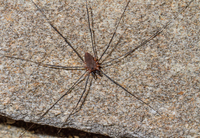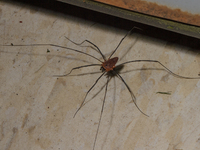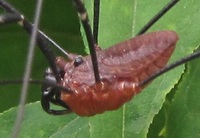Distribution Records
PDF
Vetting Levels |
|
Adult phenology:
High Mountains (HM) ≥ 4,000 ft.
Low Mountains (LM) < 4,000 ft.
Piedmont (Pd)
Coastal Plain (CP)
Click on graph to enlarge
|
 |
|
| synonym | |
| taxonomic_comments |
Approximately 30 species in this genus have been identified as occurring in North America north of Mexico (Cokendolpher and Lee, 1993; Ingianni et al., 2011), with 16 recorded in North Carolina. However, the validity of several of these species is suspect, with several that will probably be determined to be synonyms of other species, e.g., davisi, speciosum, and zimmermani in North Carolina Burns et al., 2012; Shultz, 2018). According to Shultz (2018), moreover, recent phylogenetic studies indicate both that more species are waiting to be described and that the name Leiobunum may eventually be restricted to European species, requiring new generic names for most, if not all, of our species. |
| species_comment |
Belongs to the Leiobunum Calcar Species Group as described by Ingianni et al. (2011), based on both male and female reproductive structures; further confirmed by genetic analysis (Burns et al., 2012). Other North Carolina species in this group include nigropalpi, euserratipalpe, and hoffmani. |
| id_comments |
Males are light brown to golden yellow brown, with the dorsal surface finely granulate (Ingianni et al., 2011). The ocularium is reddish-brown bordered by a dark circumocular band. The abdomen is light brown with a faint saddle; the posterior is usually pointed. Palps and legs are generally dark brown to blackish. Females are highly variable in color. |
| total_length |
6-7 mm, males; 7-9 mm, females (Shultz, 2018) |
| structural_features |
The palps of the males are greatly inflated and have a distinctive large conical spur projecting ventrolaterally from the femur. These features of the palps distinguish this species from all others in this genus except for hoffmani, which also has robust, dark palpi with large spurs on the femur (Ingianni et al., 2011). In the northwest corner of North Carolina, where these two species overlap, identification of both males and females requires microscopic examination of the reproductive structures and other key characters. Females in general are best identified by their reproductive structures (see key in Ingianni et al.). |
| silk_web |
|
| fld_guide_descriptions |
|
| online_photos |
BugGuide, The Harvestmen of Maryland |
| prey |
|
| predators |
|
| behavior |
|
| distribution_reference |
Davis (1934) |
| technical_reference |
Ingianni et al. (2011); Shultz (2018) |
| adult_id | 1 identifiable by photo 2 identifiable by photo of specific features and/or supplementary info 3 identifiable from specimen only |
| abundance |
|
| distribution_comments |
Probably confined to the Mountains in North Carolina |
checklist_mt_high
>=4,000 ft. | |
checklist_mt_low
<4,000 ft. | |
checklist_pd
Piedmont | |
checklist_cp
Coastal Plain | |
| habitat |
Recorded at both high and low elevations in the Mountains. Habitats are mostly unrecorded but several records come from the Spruce-fir zone, including at Mt. Mitchell, Grandfather Mountain, Clingman's Dome, and Richland Balsam. Habitats at lower elevations may include cove forests. |
| observation_methods |
Active diurnally and can be found by direct search of likely habitats |
| state_protection |
Arachnids are not protected under state law, although permits are needed to collect them in State Parks and other public and private nature preserves |
| NHP_ranks |
[GNR] [S3S4] |
| NHP_status |
|
| status_comments |
Not enough is yet known about its distribution, habitat associations, abundance, and population trends in North Carolina to accurately assess the conservation needs of this species. |
Photo Gallery for Leiobunum calcar No common name |
 | Recorded by: Steve Hall, Bo Sullivan, Jim Petranka, Becky Elkin
Yancey Co.
Comment: Several males observed at moth sheets and on buildings |  | Recorded by: Steve Hall, Bo Sullivan, Jim Petranka, Becky Elkin
Yancey Co.
Comment: Several males observed at moth sheets and on buildings |
 | Recorded by: Steve Hall, Bo Sullivan, Jim Petranka, Becky Elkin
Yancey Co.
Comment: Several males observed at moth sheets and on buildings |  | Recorded by: Ken Kneidel
Yancey Co.
Comment: Photo verified by J. Shultz (via iNaturalist) |
 | Recorded by: Ken Kneidel
Yancey Co.
Comment: Photo verified by J. Shultz (via iNaturalist) |